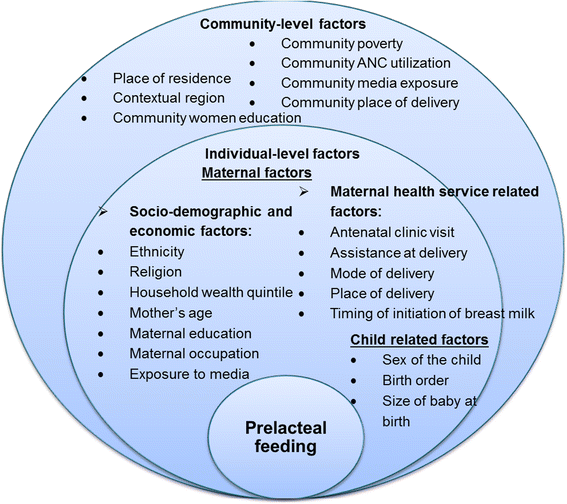Individual and community-level factors associated with introduction of prelacteal feeding in Ethiopia
- PMID: 26858835
- PMCID: PMC4745177
- DOI: 10.1186/s13690-016-0117-0
Individual and community-level factors associated with introduction of prelacteal feeding in Ethiopia
Abstract
Background: Ethiopia is a country with low optimal breast feeding practice, and prelacteal feeding is still a norm. Introduction of prelacteal feeding is a known barrier for optimal breast feeding practices. However, knowledge on determinants of introduction of prelacteal feeding is minimal. This study aimed to identify the effects of individual and community-level factors in the introduction of prelacteal feeding in Ethiopia.
Methods: Data for this study was extracted from the nationally representative 2011 Ethiopia Demographic and Health Survey (EDHS) and focused on a sample from child data, with a sample from 576 clusters of 7692 children who were last-born in the past five years preceding the survey. The data was collected using two-stage cluster design, in which enumeration areas forming the first stage and households making the second stage. A two-level mixed effect multivariable logistic regression model was fitted to determine the individual and community-level factors associated with introduction of prelacteal feeding.
Results: From the total sample of children 28.92 % were fed prelacteals. Butter (n = 1143), plain water (n = 395) and milk-other than breast milk (n = 323) were commonly used prelacteals. In multivariable two-level mixed effect model; caesarean mode of delivery (Adjusted odds ratio (AOR) = 1.87; 95 % CI 1.28, 2.73), and late initiation of breastfeeding (AOR = 5.32; 95 % CI 4.65, 6.09) were both positively associated with the odds of giving prelacteals. Higher economic status 28 % (AOR = 0.72; 95 % CI 0.54, 0.98), giving birth at hand of non-health personnel birth assistance (AOR = 0.68; 95 % CI 0.54, 0.87), large birth size of child (AOR = 0.80; 95 % CI 0.68, 0.95) and high community antenatal care use (AOR = 0.58; 95 % CI 0.38, 0.87) were negatively associated with the odds of giving prelacteals. Significant variation in prelacteal feeding practice was also seen among ethnic and religious groups, and across regions.
Conclusions: The prevalence of prelacteal feeding was high that remained a challenge for optimal breastfeeding in Ethiopia. Not only individual-level factors, but also community-level factors contribute to prelacteal feeding practice. Increasing access to health education through increasing maternal health care service coverage and community involvement is crucial.
Keywords: Ethiopia; Multilevel factors; Optimal breastfeeding; Prelacteal feeding.
Figures
Similar articles
-
Prelacteal feeding practice and associated factors among mothers of children less than two years of age in Ethiopia: A multilevel analysis.Heliyon. 2022 Apr 26;8(4):e09339. doi: 10.1016/j.heliyon.2022.e09339. eCollection 2022 Apr. Heliyon. 2022. PMID: 35520604 Free PMC article.
-
Prelacteal feeding and associated factors among newborns in rural Sidama, south Ethiopia: a community based cross-sectional survey.Int Breastfeed J. 2018 Feb 20;13:7. doi: 10.1186/s13006-018-0149-x. eCollection 2018. Int Breastfeed J. 2018. PMID: 29467812 Free PMC article.
-
Correlates of early neonatal feeding practice in Dabat HDSS site, northwest Ethiopia.Int Breastfeed J. 2017 Jun 6;12:25. doi: 10.1186/s13006-017-0116-y. eCollection 2017. Int Breastfeed J. 2017. PMID: 28592986 Free PMC article.
-
Factors associated with prelacteal feeding in the rural population of northwest Ethiopia: a community cross-sectional study.Int Breastfeed J. 2016 May 25;11:14. doi: 10.1186/s13006-016-0074-9. eCollection 2016. Int Breastfeed J. 2016. PMID: 27231482 Free PMC article.
-
Prelacteal feeding and associated factors in Ethiopia: systematic review and meta-analysis.Int Breastfeed J. 2018 Nov 28;13:49. doi: 10.1186/s13006-018-0193-6. eCollection 2018. Int Breastfeed J. 2018. PMID: 30505338 Free PMC article. Review.
Cited by
-
Prelacteal feeding and associated factors among mothers having children less than 24 months of age, in Mettu district, Southwest Ethiopia: a community based cross-sectional study.BMC Res Notes. 2019 Jan 7;12(1):9. doi: 10.1186/s13104-019-4044-3. BMC Res Notes. 2019. PMID: 30616665 Free PMC article.
-
Prelacteal feeding practice and associated factors among mothers of children less than two years of age in Ethiopia: A multilevel analysis.Heliyon. 2022 Apr 26;8(4):e09339. doi: 10.1016/j.heliyon.2022.e09339. eCollection 2022 Apr. Heliyon. 2022. PMID: 35520604 Free PMC article.
-
Prelacteal feeding practices in Pakistan: a mixed-methods study.Int Breastfeed J. 2020 Jun 8;15(1):53. doi: 10.1186/s13006-020-00295-8. Int Breastfeed J. 2020. PMID: 32513203 Free PMC article.
-
Exploring the factors associated with prelacteal feeds in Papua New Guinea: a population-based survey.BMJ Open. 2024 Dec 26;14(12):e089605. doi: 10.1136/bmjopen-2024-089605. BMJ Open. 2024. PMID: 39725435 Free PMC article.
-
Determinants of exclusive breastfeeding among infants under six months in Nepal: multilevel analysis of nationally representative household survey data.BMC Public Health. 2024 Sep 9;24(1):2456. doi: 10.1186/s12889-024-19963-z. BMC Public Health. 2024. PMID: 39251930 Free PMC article.
References
-
- FMOH . National strategy on infant and young child feeding. Edited by Family health. FMOH: Addis Ababa, Ethiopia; 2004.
-
- WHO. Infant and young child feeding: Model chapter for textbooks for medical students and allied health professionals: Geneva, Switzerland: WHO; 2009. - PubMed
-
- U.S.Department of Health and Human Services . The surgeon general’s call to action to support breastfeeding edited by U.S. Department of health and human services. Washington, DC: Office of the Surgeon General; 2011.
-
- WHO . Fulfilling the health agenda for women and children: the 2014 report. Geneva, Switzerland: UNICEF and WHO; 2014.
-
- Central Statistical Agency [Ethiopia] and ICF International. Ethiopia demographic and health survey 2011. Addis Ababa, Ethiopia and Calverton,Maryland, USA; 2012.
LinkOut - more resources
Full Text Sources
Other Literature Sources
Miscellaneous


